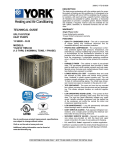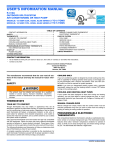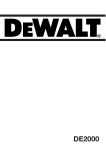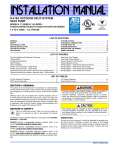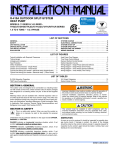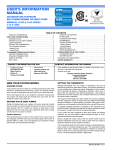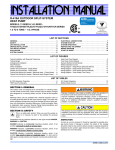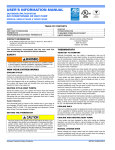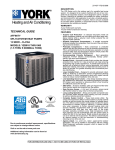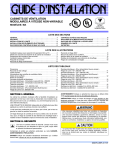Download Coleman Dual Fuel Installation manual
Transcript
ACCESSORY KIT INSTALLATION MANUAL DUAL FUEL CONTROL KIT 3024-7481/F FOR USE WITH MODELS: BRHS, BRHQ, DRHS, DRHQ, ERHS, ERHQ, THGD, GHGD, YHJD, CHJD, LHJD THERMOSTAT 3024-7481/F CONTROL FURNACE HEAT PUMP FIGURE 1: BRHS, BRHQ, DRHS, DRHQ, ERHS, ERHQ THERMOSTAT 3024-7481/F CONTROL FURNACE HEAT PUMP FIGURE 2: THGD, GHGD, YHJD, CHJD, LHJD SAFETY IMPORTANT - These instructions are intended for the use of qualified individuals specially trained and experienced in installation of this type of equipment and related system components. Installation and service personnel are required by some states to be licensed. Persons not qualified shall not install this equipment or interpret these instructions. NOTE: The words “Shall” or “Must” indicate a requirement which is essential to satisfactory and safe product performance. The words “Should” or “May” indicate a recommendation or advice which is not essential and not required but which may be useful or helpful. Installation and service personnel are required by some states to be licensed. Persons not qualified shall not install this equipment or interpret these instructions. The installer should comply with all local codes and regulations which govern the installation of this type of equipment. Improper installation may damage equipment, can create a shock hazard, and will void the warranty. Johnson Controls Unitary Products 18630-UAI-E-0808 18630-UAI-E-0808 Local codes take precedent over any recommendations contained in these instructions. In lieu of local codes, the equipment should be installed in accordance with National Electric Code and in accordance with the recommendations made by the National Board of Fire Underwriters. FIRE HAZARD – Failure to observe the following warnings could cause furnace malfunction resulting in fire or asphyxiation. 1. When indoor heat pump coils are used with fuel burning furnaces, they must be installed in the discharged air stream. Installation of a heat pump coil in the return air stream of a fuel burning furnace could cause excessive heat exchanger corrosion and burner malfunction. 2. No attempt shall be made to operate the heat pump in the heating mode at the same time the fuel burning furnace is in operation. Failure to observe this warning will result in abnormally high refrigerant temperatures and pressures resulting in system failure. Ground unit to prevent electric shock. Before making electrical connections or servicing the system, disconnect power to both the indoor and the outdoor units. GENERAL INFROMATION Contents of this Package are: 1. Heat Pump Dual Fuel Control Box 2. Outdoor Thermostat 3. User’s Information Manual (Supplementary) 4. Installation Instructions APPLICATION The 3024-7481/F heat pump dual fuel control may be used with any heat pump in conjunction with any residential fossil fuel burning furnace that has a blower capable of supplying air volumes suitable for air conditioning. It may also be used with any heat pump in conjunction with any UPG manufactured housing furnace. See Table 1 for air volume requirements. The furnace must also have a 40 VA transformer and a blower relay. 2 Nominal Tons of Air Conditioning Air Volume CFM 1-1/2 600 2 800 2-1/2 1000 3 1200 3-1/2 1400 4 1600 5 1800 The control is designed to separately operate the heating systems of the heat pump and the furnace. The only time that both will operate simultaneously is during the defrosting of the heat pump where the furnace is operated to temper the supply air to the conditioned space. During normal heating operation the wall thermostat controls the temperature of the home. The outdoor thermostat is used to select either the heat pump or the furnace, depending on its set-point. At outdoor ambient temperature above the set-point, the heat pump will operate to maintain the home comfort. Below the set-point, the furnace operates. Regardless of which system is operating, the first stage of the wall thermostat is normally in control (unless the home loses heat faster than can be compensated for by the heat pump, at which point the second stage of the wall thermostat will turn on the gas furnace until the first stage is satisfied). If the wall thermostat selection switch is placed in "Emergency Heat" position, or during a heat pump "Safety Lockout" the furnace will provide all heat. Normal operation will be resumed when the "System" switch is returned to the "Heat" position, or when the Safety Lockout" is reset (see heat pump instructions for further information about a "Safety Lockout" condition). Read these instruction carefully before the installation of any component of the heat pump system. Where these instructions differ from the instruction packed with other components, these instructions shall take precedence. Otherwise, use components that do not differ as a guide line for installing those components. In most cases, the control package should not be retrofitted to gun furnaces; use a 3024C7473 control package for these applications. The 3024C7473 control includes a 40 VA transformer, blower motor terminals, and a blower control relay that are required for such applications. Do not install any coil to a furnace which is to be operated during the heating season without attaching the refrigerant lines to the coil and opening the system service valves. Failure to do so will cause excessive pressures within the coil that could damage the coil and cause personal injury. NOTE: 1. The heat pump outdoor unit, indoor coil, and refrigerant line set must be matched up as shown in the tabular data sheet packed with the heat pump outdoor unit. 2. For horizontal coil applications, field fabricated blank-off plates or transition plenum may be required to fit the coil cabinet to the furnace outlet flanges. 3. Amp. draw for the wall thermostat's first stage heat anticipator is a non-adjustable .6 amp. The second stage anticipator should be adjusted to .3 amp. Johnson Controls Unitary Products 18630-UAI-E-0808 INSTALLATION ON GAS OR OIL FURNACE SHOCK HAZARD - Disconnect electric power to equipment before installation to prevent equipment damage and possible personal injury. The furnace must have a blower capable of delivering the air volume specified in Table 1 and be air conditioning ready. Install heat pump coil and cabinet onto the outlet of the furnace. See instruction packed with these components. Route the refrigerant lines from the outdoor heat pump unit to the indoor heat pump coil per the instructions packed with the heat pump. Mount the 3024-7481/F control box on the outside of the furnace casing or on a wall near the furnace. The control box may be located outside directly on certain outside gas furnaces. The location and installation must conform to approved electrical codes. If the furnace does not have a 40 VA (or larger) transformer, and an A/C blower relay, those items must be installed at this time. Low voltage control wiring to the furnace, wall thermostat, outdoor heat pump unit, and 3024-7481/F control box should be connected per Figures 1, 2, and 3. Installation of Outdoor Thermostat Location The outdoor thermostat is designed to be installed in an outdoor environment. However, constant shade is the determining factor in selecting a location for the outdoor thermostat. Radiant heat from direct rays of the sun could affect the operation of the thermostat. There may be some heat pump models that provide an attachment location for the outdoor thermostat, most models do not. Careful selection should be used in locating the outdoor thermostat. The electric cable provided is long enough to allow the thermostat to be mounted on a nearby structure. Wiring Remove the cover from the heat pump control box. Route the end of the cable through the grommet and into the low voltage box. Connect cable to the correct terminations. See Figure 3. Coil and neatly tie excess cable. Replace cover in unit control box and set outdoor thermostat. Setting the Outdoor Thermostat IMPORTANT - The outdoor thermostat should not set lower than the application balance point temperature. It is permissible to set the outdoor thermostat above this temperature if it is economically beneficial. Johnson Controls Unitary Products Determining the application balance point: Before setting the outdoor thermostat, a heat loss calculation must be made of the home. The heat loss of a home is assumed to be linear and inversely proportionate to the outdoor temperature. As the outdoor temperature drops, the heat loss of the home increases. Conversely, the heat pump capacity is reduced as the outdoor temperature drops. At some outdoor temperature, heat pump capacity will balance with the home heat loss. In other words, at the temperature, the heat loss of the home will be identical to the amount of heat produced by the heat pump. In order to determine the exact temperature, it is necessary to chart the heat loss against the capacity of the heat pump. See the heat pump application data for the capacity information at various outdoor temperatures. Chart the capacities of the heat pump at the corresponding outdoor temperatures on a graph and connect the points. See Figure 4 “Example Chart 1”. The vertical axis represents BTU per hour (in thousands) and the horizontal axis represents outdoor temperature. For this example, the heating performance data for 024 model is shown as Figure 6 and was obtained from the Technical Guide for 018 models thru 060 13 SEER R-22 Split System Heat Pump. First, the outdoor unit is matched to an indoor coil and the corresponding multipliers are selected; for this example, MH30S is selected as shown. In addition, assume air entering the indoor coil is 70ºF (temperature at which the room is to be maintained) and indoor CFM is 600. Then plot BTU per hour against outdoor temperature as shown with diamond symbol. Draw a straight line that best fits all the points. For instance, for 47°F outdoor air, the “BTUH x 1000” value would be: Thousand British Thermal Units per Hour (MBTUH) value at 47°F Outdoor and 70°F indoor X MH30S coil multiplier for Thousand British Thermal Units per Hour (MBH) = 22.3 x 1.0 = 22.3 BTUH x 1000. In addition, for the purpose of this example, assume that the calculated heat loss of the home is 50,800 BTU’s per hour at an outdoor design temperature of + 10º F. Moving up the vertical axis, at + 10º F, locate the number of BTU’s per hour heat loss and mark that point on the graph. Placing a straight edge on this point, and aligning with the 70º F, (the normal indoor comfort condition) in the lower right-hand corner, connect these two points with a straight line. Locate the point at which the heat loss crosses the capacity curve of the heat pump. This intersection is the application balance point temperature for the example application. 3 18630-UAI-E-0808 YEL YEL YEL BLK RED WHT GRN R Y G W2 S2 S1 DEFROST RELAY A B FURNACE RELAY A B 7 4 Y 5 9 WHT ORG 1 4 1 7 8 5 8 3 9 3 FIGURE 3: Wiring Diagram - 3024-7481/F Heat Pump Dual Fuel Control Kit S2 CONNECT TO B GRN 2 RED 1 3 WHT W2 FIGURE 4: Wiring Diagram - 3024-671/F Outdoor Thermostat INDOOR THERMOSTAT B O L X W2 R Y G 3024-7481/F CONTROL B O L X W2 R Y G RED R ORG O PUR B O R C L W X E W2 S2 S1 BLK Y GRN WHT RED GRN WHT BLU RED C W FURNACE Y BRN G OUTDOOR THERMOSTAT * WHT +* GRY W1/66 W CC HEAT PUMP * R C YEL G X/L THIS WIRE MUST BE CLOSED WITH WIRE NUT TO PREVENT ELECTRICAL MALFUNCTION. + THIS GREY (GRY) WIRE FROM CONTACTOR COIL (CC) IS NOT PRESENT IN SOME MODELS. FIGURE 5: Wiring Connections 4 Johnson Controls Unitary Products 18630-UAI-E-0808 EXAMPLE CHART 1 70 DESIGN TEMPERATURE 60 B T U H 50 40 1 0 0 0 APPLICATION BALANCE POINT HEAT LOSS X 30 HEAT PUMP CAPACITY ECONOMIC BALANCE POINT 20 10 0 0 10 20 30 40 50 60 70 60 70 OUTDOOR TEMPERATURE °F FIGURE 6: Example Chart 1 WORKSHEET 1 (For Example Chart 1) 70 60 B T U H 50 40 X 1 0 0 0 30 20 10 0 0 10 20 30 40 50 OUTDOOR TEMPERATURE °F FIGURE 7: Worksheet 1 NOTES FOR WORKSHEET 1 Johnson Controls Unitary Products 5 18630-UAI-E-0808 Determining the economical balance point: Determine the cost of electricity, price and type of furnace fuel (natural gas, propane, or heating oil), and efficiency of furnace. For the purpose of this example, assume cost of electricity is $0.10 per KWh, cost of natural gas is $0.84 per therm, and furnace efficiency is 90%. The KW values from the same heat pump application data of Figure 6 is used for this section and the result is plotted as shown with triangle symbol in Figure 7 “Example Chart 2”. The vertical axis represents BTU (in thousands) per dollar and the horizontal axis represents outdoor temperature. For electricity calculation, plot BTU per $ against outdoor temperature. For instance, for 40°F outdoor air, the “BTU x 1000 per $” value would be: Thousand British MH30S coil multiplier Kilowatt (KW) Cost of MH30S coil Thermal Units per for Thousand British at 47°F multiplier for Hour (MBTUH) value X Thermal Units per ³ electricity ³ value ³ Outdoor and ($/KWh) Kilowatt (KW) at 47°F Outdoor and Hour (MBH) 70°F indoor 70°F indoor = 19.3 x 1.0 x (1 / 0.10) x (1 / 1.8) x (1 /1.0) = 107 BTU x 1000 per $. This value is the amount of heat the heat pump provides for each dollar spent for electricity to operate the heat pump. For the furnace fuel calculation, plot the BTU per $ against outdoor temperature. This is usually a linear horizontal line. For instance, for the natural gas example, the “BTU x 1000 per $” value would be: Furnace Efficiency ³ Cost of natural gas ($/therm) 100000 BTU* X 1 therm 1 X 1000 = 0.9 x (1 / 0.84) x (100000 / 1) x (1 / 1000) = 107 BTU x 1000 per $. This value is the amount of heat the furnace provides for each dollar spent for natural gas. If using heating oil furnace, then apply: Furnace Efficiency ³ Cost of heating oil ($/gal) X 139000 BTU* 1 gal X 1 1000 If using propane furnace, then apply: Furnace Efficiency ³ Cost of propane ($/gal) X 916000 BTU* These plots represent the fuel and electrical costs. Where these two costs intersect is the economical balance point. It is where $1.00 will purchase the same amount of BTU’s from either the heat pump or the furnace. Mark the economic balance point for later reference. In summary, this application example shows an economic balance point of 40º F for a 13 SEER heat pump and a 90% natural gas furnace using $0.10/KW electricity and $0.84/therm. gas. Adjusting Thermostat Set Point On the chart that you determined the application balance point for your particular application as shown in Figure 4. Mark and label the economical balance point temperature on the curve representing the heat loss of the structure. 1 gal X 1 1000 Remove the outdoor thermostat cover. The thermostat is factory set at 30º F. It should be adjusted to the higher of the two temperatures marked on “heat loss” curve whether it be the application or economical balance point. Adjust by turning the slot on the thermostat shaft to align with the new temperature setting. Should the economic balance point be lower than the application balance point, and the outdoor thermostat is set to this temperature, the control will operate the heat pump until the home temperature drops to close the second stage of the wall thermostat, at which time the heat pump will be turned off and the furnace will operate. Under this condition, the furnace will continue to operate until the home temperature rises to satisfy the first stage. When the first stage of the wall thermostat closes again, the control will operate the heat pump and the cycle will repeat to maintain the home comfort. Replace the outdoor thermostat cover. Energy conversion Factor for furnace fuels (propane, heating oil, natural gas) changes with every batch of fuel. 6 Johnson Controls Unitary Products 18630-UAI-E-0808 HEATING PERFORMANCE DATA CONDENSING UNIT MODEL NO ERHS0241BA EVAPORATOR COIL MODEL NO FC/MC/PC/UC24 AIR TEMP. ENTERING OUTDOOR UNIT AIR TEMP. ENTERING INDOOR COIL 60 47 40 30 17 10 ID CFM 600 800 1000 MBTUH KW C.O.P. MBTUH KW C.O.P. MBTUH KW C.O.P. 60 26.5 2.1 3.7 21.7 0.7 8.8 25.5 1.9 3.9 70 25.6 2.1 3.5 20.7 1.1 6.3 25.4 2.0 3.7 80 24.6 2.2 3.3 19.7 1.6 3.7 25.2 2.1 3.5 60 23.4 1.8 3.7 18.4 1.3 4.1 22.4 1.7 3.8 70 22.3 1.9 3.5 17.3 1.0 5.6 22.3 1.8 3.6 80 21.1 1.9 3.2 16.3 0.7 7.0 22.2 1.9 3.5 60 20.4 1.7 3.5 16.4 1.2 3.9 20.7 1.6 3.7 70 19.3 1.8 3.2 15.3 1.3 3.5 20.4 1.7 3.5 80 18.2 1.8 2.9 14.1 1.3 3.1 20.2 1.8 3.4 60 18.8 1.6 3.4 13.8 1.2 3.4 19.0 1.5 3.6 70 16.9 1.6 3.0 12.7 1.2 3.1 17.8 1.6 3.3 80 15.0 1.7 2.6 11.7 1.2 2.8 16.6 1.6 3.0 60 13.3 1.5 2.6 10.0 1.1 2.6 15.3 1.4 3.1 70 11.4 1.5 2.2 9.0 1.1 2.3 13.0 1.5 2.6 80 9.5 1.6 1.8 8.0 1.2 2.0 10.8 1.5 2.0 60 12.0 1.5 2.4 8.9 1.1 2.3 11.8 1.4 2.5 70 9.6 1.5 1.9 8.0 1.1 2.1 10.0 1.5 2.0 80 7.2 1.6 1.4 7.0 1.2 1.8 8.2 1.5 1.6 NOTE: ALL CAPACITIES ARE NET WITH INDOOR FAN HEAT ALREADY DEDUCTED AT 1250 BTUH/1000 CFM. Multipliers for determining the performance with other indoor sections. Air Handler Coil MBH KW COP MA08B FC/MC24B 1.00 1.00 1.00 MA08B FC/MC30B 1.00 1.00 1.00 MA08B FC/MC36B 1.00 1.00 1.00 AHP24 – 1.00 1.00 1.00 F*FP030 – 1.00 1.00 1.00 MV12B FC/MC24B 0.97 0.93 0.90 MV12B FC/MC30B 0.97 0.93 0.90 AV24 – 0.97 0.93 0.90 – FC/MC/PC/UC30 1.00 1.00 1.00 – FC/MC/PC/UC36 1.00 1.00 1.00 – HC30 1.00 1.01 1.01 – HD24 1.00 1.00 1.00 – MH30S 1.00 1.00 1.00 Variable Speed Coil Furnace MBH KW COP (F,L)C8VA12 FC/MC/PC24A 0.97 0.96 0.93 FC9VA12 FC/MC/PC24A 0.97 0.96 0.93 FC9(C,V)B12 FC/MC/PC24B 0.97 0.96 0.93 (F,L)C8VA12 FC/MC/PC30A 0.97 0.96 0.93 FC9VA12 FC/MC/PC30A 0.97 0.96 0.93 FC9(C,V)B12 FC/MC/PC30B 0.97 0.96 0.93 (F,L)C8VA12 FC/MC/PC36A 0.97 0.96 0.93 FC9VA12 FC/MC/PC36A 0.97 0.96 0.93 FC9(C,V)B12 FC/MC/PC36B 0.97 0.96 0.93 (F,L)C8VA12 HC30 1.00 1.01 1.01 FC9VA12 HC30 1.00 1.01 1.01 (F,L)C8VA12 HD30 0.97 0.96 0.93 FC9VA12 HD30 0.97 0.96 0.93 FIGURE 8: ERHS024 Extract from Technical Guide for ERHS018 thru 060 13 SEER R-22 Split System Heat Pump Johnson Controls Unitary Products 7 18630-UAI-E-0808 HEATING PERFORMANCE DATA CONDENSING UNIT MODEL NO THGD24S21S1 EVAPORATOR COIL MODEL NO AHP24 AIR TEMP. ENTERING OUTDOOR UNIT 60 47 40 30 17 10 AIR TEMP. ENTERING INDOOR COIL ID CFM 600 800 1000 MBTUH KW C.O.P. MBTUH KW C.O.P. MBTUH KW C.O.P. 60 25.6 4.23 1.77 26.9 4.47 1.76 28.3 4.70 1.76 70 24.4 4.09 1.75 25.8 4.41 1.71 27.3 4.75 1.68 80 23.2 3.95 1.72 24.7 4.35 1.66 26.2 4.79 1.60 60 21.8 4.46 1.43 23.1 4.90 1.38 24.3 5.35 1.33 70 20.6 4.03 1.51 21.9 4.20 1.56 23.2 4.40 1.61 80 19.4 3.59 1.58 20.7 3.50 1.73 22.1 3.44 1.88 60 19.5 4.10 1.39 20.8 4.54 1.34 22.0 4.99 1.29 70 18.6 3.76 1.46 19.8 4.12 1.42 21.0 4.49 1.38 80 17.7 3.41 1.52 18.8 3.69 1.49 19.9 3.99 1.46 60 17.3 3.95 1.28 18.0 4.15 1.27 18.7 4.34 1.26 70 16.0 3.54 1.33 16.8 3.73 1.33 17.6 3.93 1.32 80 14.7 3.12 1.38 15.6 3.31 1.38 16.5 3.52 1.37 60 12.8 2.71 1.38 13.5 3.16 1.25 14.1 3.68 1.12 70 11.7 2.67 1.28 12.4 2.98 1.21 13.0 3.33 1.14 80 10.6 2.63 1.18 11.2 2.80 1.17 11.8 2.97 1.16 60 9.5 2.67 1.04 10.7 2.92 1.07 11.9 3.16 1.10 70 9.2 2.50 1.08 10.1 2.71 1.09 10.9 2.91 1.10 80 8.9 2.32 1.12 9.4 2.50 1.10 9.9 2.66 1.09 NOTE: ALL CAPACITIES ARE NET (KBTUH) WITH INDOOR FAN HEAT ALREADY DEDUCTED AT 1250 BTUH/1000 CFM. Multipliers for determining the performance with other indoor sections. Air Handler – – – – – – – – – AHP30 AV24 FPFP030 MV12B MA08B MV12B MA08B MV12B MA08B Coil FC/MC/PC/UC24 FC/MC/PC/UC30 FC/MC/PC/UC32 FC/MC/PC/UC35 HC30 HC36 HD24 MH24S MH30S – – – FC/MC24B FC/MC24B FC/MC30B FC/MC30B FC/MC35B FC/MC35B MBH 1.00 1.00 1.00 1.00 1.00 1.00 1.00 1.00 1.00 1.00 0.97 1.00 0.98 1.00 0.98 1.00 0.97 1.00 KW 1.00 1.00 1.00 1.00 1.00 1.00 1.00 1.00 1.00 1.00 1.08 1.00 1.07 1.00 1.07 1.00 1.07 1.00 COP 1.00 1.00 1.00 1.00 1.00 1.00 1.00 1.00 1.00 1.00 0.92 1.00 0.93 1.00 0.93 1.00 0.93 1.00 Variable Speed Furnace PV8*A12 PV9*A12 P(C,V)9*B12 PV8*A12 PV9*A12 P(C,V)9*B12 PV8*A12 PV9*A12 P(C,V)9*B12 PV8*A12 PV9*A12 P(C,V)9*B12 Coil MBH KW COP FC/MC/PC/UC24A FC/MC/PC/UC24A FC/MC/PC/UC24B FC/MC/PC/UC30A FC/MC/PC/UC30A FC/MC/PC/UC30B FC/MC/PC/UC32A FC/MC/PC/UC32A FC/MC/PC/UC35B HC30 HC30 HC36 0.98 0.98 0.98 0.98 0.98 0.98 0.98 0.98 0.98 0.98 0.98 0.98 1.05 1.04 1.05 1.05 1.05 1.05 1.05 1.05 1.05 1.05 1.05 1.05 0.95 0.96 0.95 0.95 0.95 0.95 0.95 0.95 0.95 0.95 0.95 0.95 FIGURE 9: THGD24 Extract from Technical Guide for THGD24 thru 60 13 SEER R-22 Split System Heat Pump 8 Johnson Controls Unitary Products 18630-UAI-E-0808 EXAMPLE CHART 2 B T U H X 140 120 1 0 0 0 80 P E R 40 $ FURNACE FUEL 100 ELECTRICITY ECONOMIC BALANCE POINT 60 20 0 -10 0 10 20 30 40 50 60 70 80 OUTDOOR TEMPERATURE °F FIGURE 10: Example Chart 2 NOTES FOR WORKSHEET 2 Johnson Controls Unitary Products 9 18630-UAI-E-0808 WORKSHEET 2 (For Example Chart 2) 380 360 340 320 B T U H 300 280 X 260 1 0 0 0 240 P E R $ 220 200 180 160 140 120 100 80 60 40 20 0 -10 0 10 20 30 40 50 60 70 80 OUTDOOR TEMPERATURE °F FIGURE 11: Worksheet 2 10 Johnson Controls Unitary Products 18630-UAI-E-0808 SYSTEM OPERATIONAL CHECK-OUT NOTE: If a programmable wall thermostat is used on this application, there will be a five minute delay when the system is powered up for the first time, and if the system switch is moved to another mode. See instructions packed with the thermostat. 1. Make sure all service disconnects are open. 2. Set thermostat switches as follows: a. b. Fan switch to “Auto”. System switch to “Off”. 14. Turn wall thermostat system switch to “Heat”. a. b. c. d. e. f. g. Emergency heat light should turn off. Auxiliary light should remain on. Furnace should continue to operate. Furnace blower should operate. Outdoor unit compressor should not operate. Outdoor unit fan should not operate. Warm air should continue to flow from the registers. 15. Set outdoor thermostat below outdoor temperature. 3. Close disconnect to heat pump outdoor unit. 4. Close disconnect to furnace. 5. Turn thermostat fan switch to “On”. Blower should operate. 6. Turn fan switch back to “Auto”. Blower should stop within 90 seconds. 7. Turn system switch to “Cool” and set thermostat temperature setting below room temperature 16. Reset outdoor thermostat to its operating temperature (see: Setting the Outdoor Thermostat). a. b. c. d. 17. Set system switch to desired mode and adjust temperature lever to desired temperature if everything checks out correctly. Outdoor unit compressor should operate. Outdoor unit fan should operate. Furnace blower should operate. Cool air should flow from registers after system has operated for a few minutes. 8. Turn system switch to “Off” and wait 5 minutes. 9. Turn system switch to “Heat” and set thermostat setting above room temperature just enough to close the first stage. Set the outdoor thermostat above the outdoor temperature. a. b. c. d. Outdoor unit compressor should operate. Outdoor unit fan should operate. Furnace blower should operate. Warm air should flow from registers after the system has operated for a few minutes. 10. Set thermostat to higher temperature to close the second stage. a. b. c. d. e. Outdoor unit compressor should not operate. Outdoor unit fan should not operate. Furnace should operate. Furnace blower should operate. Warm air should flow from the registers after a few minutes. 11. Set thermostat to lower temperature to insure heating system cycles off. 12. Turn wall thermostat system switch to “Emergency Heat”. Emergency heat light should turn on, but nothing should operate. 13. 13. Set thermostat to higher temperature to close the second stage. a. b. c. d. e. a. b. c. d. e. Furnace should stop operating. Furnace blower should operate. Outdoor unit compressor should operate. Outdoor unit fan should operate. Warm air should continue to flow from the registers. NOTE: In the heating mode the indoor wall thermostat controls the system operation to maintain the selected temperature, operating either the heat pump or the furnace to do so. The selection of either is controlled by the outdoor thermostat, i.e. at temperatures above the setting, the heat pump operates in response to the first stage of the wall thermostat, at temperatures below the setting of the outdoor thermostat the furnace operates (also see the outdoor thermostat installation). Exceptions to the above: A. If the heat pump fails to operate in the heating mode due to high refrigerant pressure or temperature, the furnace will operate regardless of the status of the outdoor thermostat. B. If the system switch of the wall thermostat is placed in “Emergency Heat” position, only the furnace will operate. C. If a defrost cycle is initiated by the heat pump, both the heat pump and the furnace will operate until the defrost cycle is completed. NOTE: In both A and B above, the furnace operation is controlled by the second stage of the wall thermostat. During the defrost cycle the furnace is controlled by the first stage. NOTE: The heat pump has a safety lockout that will keep it from operating if some fault causes the high temperature or the high pressure limit switches to open. To reset the lockout, turn the indoor thermostat system to “Off”, then back to the selected mode within 5 seconds or disconnect the power to the transformer for at least two seconds. The heat pump will now operate. Should a lockout re--occur, then the cause of the lockout should be sought and corrected immediately. Emergency light should be on. Auxiliary heat light should turn on. Furnace should operate. Furnace blower should operate. Warm air should flow from the registers after a few minutes. Johnson Controls Unitary Products 11 NOTES Subject to change without notice. Printed in U.S.A. Copyright © 2008 by Johnson Controls, Inc. All rights reserved. Johnson Controls Unitary Products 5005 York Drive Norman, OK 73069 18630-UAI-E-0808 Supersedes: 18630-UAI-D-0108












